19. Kongress der Association Internationale pour l'Histoire du Verre ...
19. Kongress der Association Internationale pour l'Histoire du Verre ...
19. Kongress der Association Internationale pour l'Histoire du Verre ...
You also want an ePaper? Increase the reach of your titles
YUMPU automatically turns print PDFs into web optimized ePapers that Google loves.
Pressglas-Korrespondenz 2012-3<br />
Abb. 2012-3/63-01, <strong>19.</strong> <strong>Kongress</strong> AIHV 2012, Piran, Slowenien<br />
Piran, Hafen mit Palast Trevisini, Altstadt, Platz Tartinini, Kirche St. Georg [Cerkev Sv. Jurija], aus http://de.wikipedia.org/wiki/Piran<br />
SG Oktober 2012<br />
<strong>19.</strong> <strong>Kongress</strong> <strong>der</strong> <strong>Association</strong> <strong>Internationale</strong> <strong>pour</strong> l’Histoire <strong>du</strong> <strong>Verre</strong> (AIHV)<br />
Piran, Slowenien, 17. - 21. September 2012, Kurzbericht<br />
AIHV 19 Piran Slovenia 2012<br />
Programme and Abstract Book<br />
Livre de Programme et des Résumés<br />
Abb. 2012-3/63-02, <strong>19.</strong> <strong>Kongress</strong> AIHV 2012, Piran, Slowenien<br />
Programme and Abstract Book - Livre de Programme et des<br />
Résumés, Piran / Koper 2012, Einband<br />
19 th Congress of the International <strong>Association</strong><br />
for the History of Glass<br />
19e Congres de l’<strong>Association</strong> <strong>Internationale</strong><br />
<strong>pour</strong> l’Histoire <strong>du</strong> <strong>Verre</strong><br />
17 th -21 st September 2012, Piran, Slovenia<br />
Edited by Irena Lazar<br />
Publisher: Univerza na Primorskem,<br />
Znanstveno-raziskovalno središče<br />
Printing: 250 copies<br />
Koper 2012<br />
ISBN 978-961-6862-25-7<br />
Contents - Table des matieres<br />
Foreword - Preface.........................................................5<br />
Organizer - Organisateur .............................................11<br />
Committees - Comites .................................................15<br />
Honorary committee - Comite honoraire.....................19<br />
Scientific advisory committee -<br />
Comite d'avis scientifique<br />
Organizing committee - Comite d'organisation<br />
AIHV committee 2012 - AIHV Comite 2012<br />
Sponsors and Donors - Sponsors et Donateurs<br />
Venues - Lieux [Tagungsorte] .....................................23<br />
Programme - Programme.............................................29<br />
Oral sessions - Sessions orales<br />
List of poster contributions -<br />
Liste des contributions poster<br />
Session 1 (Wednesday)<br />
Session 2 (Thursday)<br />
Abstracts - Résumés.....................................................49<br />
Oral sessions - Sessions orales<br />
(in alphabetical or<strong>der</strong> by first author - en ordre<br />
alphabetique par premier auteur)<br />
Poster contributions - Contributions poster<br />
Stand 12.10.2012 PK 2012-3/63 Seite 1 von 11 Seiten
Pressglas-Korrespondenz 2012-3<br />
(in alphabetical or<strong>der</strong> by first author - en ordre<br />
alphabetique par premier auteur)<br />
Post-congress tour - Voyage post-congres ................ 155<br />
List of participants - Liste des participants................ 171<br />
Irena Lazar<br />
President of the Organizing Committee of the<br />
19th AIHV and vice-president of the AIHV<br />
Vorwort<br />
[Übersetzung aus dem Englischen SG]<br />
Der <strong>19.</strong> AIHV <strong>Kongress</strong> (AIHV - <strong>Association</strong><br />
<strong>Internationale</strong> <strong>pour</strong> <strong>l'Histoire</strong> <strong>du</strong> <strong>Verre</strong> / <strong>Internationale</strong><br />
Gesellschaft für die Geschichte des Glases), <strong>der</strong><br />
zwischen dem 17. und 21. September 2012 in Piran<br />
stattfinden wird, wird zum ersten Mal in seiner fast 60jährigen<br />
Geschichte in Slowenien stattfinden. Als Teil<br />
seines Programms <strong>der</strong> Besuche in Sammlungen und<br />
Museen schließt <strong>der</strong> <strong>Kongress</strong> die Zusammenarbeit mit<br />
Kollegen und Institutionen in Italien und Kroatien ein.<br />
Wir fühlen uns geehrt und sind stolz, in <strong>der</strong> Lage sein,<br />
den weltweit größten <strong>Kongress</strong> von Glasforschern<br />
und eine <strong>der</strong> größten archäologischen Konferenzen<br />
<strong>der</strong> ganzen Welt in <strong>der</strong> Stadt Piran in Slowenien<br />
abzuhalten.<br />
Die Gesellschaft AIHV organisierte ihren ersten<br />
<strong>Kongress</strong> 1958 in Liège [Lüttich] in Belgien und<br />
danach alle drei Jahre. Es folgten <strong>Kongress</strong>e in Leyden<br />
1961, Damaskus 1964, Ravenna-Venedig 1967, Prag<br />
1970, Köln 1973, Berlin-Leipzig 1977, London-<br />
Liverpool 1979, Nancy 1983, Madrid-Segovia 1985,<br />
Basel 1988, Wien 1991, in den Nie<strong>der</strong>landen 1995,<br />
Venedig, Mailand 1998, New York-Corning 2001,<br />
London 2003, Antwerpen 2006 und Thessaloniki<br />
2009. Auf dem letzten <strong>Kongress</strong> in Griechenland,<br />
beschlossen die Mitglie<strong>der</strong> des AIHV, dass <strong>der</strong> nächste<br />
<strong>Kongress</strong> von <strong>der</strong> Universität Primorska in Slowenien<br />
organisiert werden wird.<br />
Der Zweck des Weltkongresses und <strong>der</strong> Gesellschaft<br />
AIHV, die im Jahr 1956 in Belgien gegründet wurde,<br />
ist die Archäologen, Kunsthistoriker, Sammler von<br />
Glasobjekten, Glastechnologen, Museumsdirektoren<br />
und Wissenschaftler auf dem Gebiet <strong>der</strong> Wissenschaft,<br />
Technologie und Archäometrie zu verbinden, das<br />
Studium sozioökonomischer und soziokultureller<br />
Aspekte <strong>der</strong> Glasherstellung, Gestaltung und Nutzung<br />
von ihren Anfängen bis zu späteren Perioden.<br />
Der wissenschaftliche Teil des <strong>19.</strong> <strong>Kongress</strong>es umfasst<br />
78 Vorträge, die in zwei parallelen Sektionen<br />
stattfinden und wird in 12 Themen unterteilt. Die<br />
Vorträge werden von 74 Posterbeiträge ergänzt<br />
werden. Die Teilnehmer und Referenten aus 32<br />
Län<strong>der</strong>n kommen aus allen fünf Kontinenten.<br />
Anzumerken ist, dass wir zum ersten Mal eine große<br />
Anzahl von Forschern aus dem Balkan (Bosnien und<br />
Herzegowina, Kroatien, Serbien, Mazedonien,<br />
Albanien) erwarten, die die Ergebnisse ihrer Arbeit und<br />
Forschung präsentieren werden.<br />
Während des <strong>Kongress</strong>es, organisieren wir den Verkauf<br />
verschiedener Publikationen zum Thema Glas,<br />
ausgestellt von lokalen und ausländischen Institutionen<br />
und Verlagen. Der Verkauf wird im Trevisini-Palast<br />
stattfinden, <strong>der</strong> auch Austragungsort des <strong>Kongress</strong>es<br />
wird.<br />
Das Begleitprogramm <strong>der</strong> Konferenz wird von einer<br />
kleinen Ausstellung von slowenischen Künstlern im<br />
Bereich des Glas-Design, eine Tour des kulturellen<br />
Erbes von Piran und Besuche bei den nationalen<br />
Glaskollektionen von Museen in Ljubljana und<br />
Aquileia in Italien statt bestehen. Der wissenschaftliche<br />
Teil <strong>der</strong> Tagung werden in einem 2-tägigen Exkursion<br />
nach dem <strong>Kongress</strong> (22. bis 23. September 2012)<br />
gipfeln, die den Teilnehmern erlauben wird, das<br />
kulturelle Erbe und die Glasmuseen und Sammlungen<br />
<strong>der</strong> Republik Slowenien und Kroatien zu besichtigen.<br />
Das Organisationskomitee dankt allen, die ihre Hilfe,<br />
die Unterstützung und Spenden angeboten haben und all<br />
denen, die an <strong>der</strong> Organisation und Durchführung des<br />
<strong>Kongress</strong>es, <strong>der</strong> Museumsbesuche und <strong>der</strong><br />
wissenschaftlichen Exkursion teilgenommen haben.<br />
SG, Kurzbericht<br />
Die weitaus meisten Vorträge wurden in Englisch<br />
gehalten, nur wenige in Französisch. Selbst wenn man<br />
gut Englisch kann, sind Vorträge schwer zu verstehen,<br />
wenn Englisch für den Vortragenden ebenso eine<br />
Fremdsprache ist und <strong>der</strong> Vortrag vom Bildschirm<br />
abgelesen wird. Aber da<strong>du</strong>rch, dass fast ausnahmslos<br />
alle Vorträge mit guten Bil<strong>der</strong>n illustriert wurden und<br />
mit Hilfe <strong>der</strong> englischen Summarys gab es nur wenige<br />
Probleme. Interessante Bücher wurden angeboten.<br />
Ich war das erste Mal auf einem AIHV-<strong>Kongress</strong>, vor<br />
allem wegen <strong>der</strong> angebotenen Exkursionen nach<br />
Italien / Aquilea, Slowenien / Ljubljana, Novo Mesto,<br />
Kroatien / Zagreb, Split, Biograd, Zadar. Außerdem<br />
muss mann immer 3 Jahre warten, bis das Protokoll, die<br />
Annales, vom AIHV-<strong>Kongress</strong> herausgebracht werden.<br />
Mein Eindruck war uneingeschränkt positiv. Der<br />
<strong>Kongress</strong> und die Exkursionen waren hervorragend<br />
organisiert von Dr. Irena Lazar und ihren<br />
MitarbeiterInnen. Ich hatte den Eindruck, dass mehr<br />
als sonst junge WissenschaftlerInnen ihre Ergebnisse<br />
vorgetragen haben, die mit Computern keine Probleme<br />
habe, was sich auch auf die Folienvorträge sehr positiv<br />
auswirkte. Selbstverständlich waren alle bisher weit<br />
bekannten Größen <strong>der</strong> Glasforschung anwesend, u.a.<br />
Ian Freestone, Sylvia Fünfschilling, Despina Ignatiadou,<br />
Marie-Dominique Nenna, Lisa Pilosi, Jennifer Price,<br />
Jane Shadel Spillman, E. Marianne Stern, David<br />
Whitehouse und selbstverständlich Irena Lazar.<br />
Rosemarie Lierke trug ihre Ergebnisse bei <strong>der</strong><br />
Beurteilung berühmter antiker Gläser vor und bekam<br />
kaum noch Wi<strong>der</strong>spruch von den „Autoritäten“. Es gab<br />
unter allen Teilnehmern eine sehr freundschaftliche<br />
Atmosphäre.<br />
Neu waren diesmal viele Vertreter aus den slawischen<br />
Län<strong>der</strong>n, aus dem ehemaligen Jugoslawien und aus<br />
Russland, sowie aus <strong>der</strong> Türkei. Griechenland ist<br />
endgültig in <strong>der</strong> AIHV angekommen. Diese Län<strong>der</strong><br />
hatte man bisher kaum beachtet. Der Anteil junger<br />
Seite 2 von 11 Seiten PK 2012-3/63 Stand 12.10.2012
Pressglas-Korrespondenz 2012-3<br />
Frauen aus ganz Europa war sehr groß - sie verdrängen<br />
anscheinend die Männer aus <strong>der</strong> Glasforschung und<br />
trauen sich an Computer heran … An<strong>der</strong>erseits fällt es<br />
manchen Wissenschaftlern schwer, ihre Ergebnisse gut<br />
zu verkaufen, obwohl sie ja damit Geld für weitere<br />
Forschungen werben wollen. Manche vergessen auch<br />
über <strong>der</strong> Freude an Unmengen von Feindaten, für was<br />
diese eigentlich ermittelt wurden …<br />
Die Zusammenarbeit von Glasforschern mit <strong>der</strong><br />
Archäologie und <strong>der</strong> Archäometrie ist weiter voran<br />
gekommen, auch dank <strong>der</strong> immer weiter verbesserten<br />
technischen Methoden zur Untersuchung von<br />
Glasproben. Die reine Beschreibung von Gläsern, wie<br />
sie unter „alten“ Glasforschern beliebt war, ist ganz<br />
verschwunden, dafür gibt es ja schließlich Bil<strong>der</strong> zum<br />
Vortrag. Vielleicht liegt das auch daran, dass bei<br />
umfangreichen Ausgrabungen heute kaum mehr ganze<br />
Glasgefäße gefunden werden, aber Unmengen von<br />
Scherben, von denen man ohne Probleme Stücke zur<br />
Messung und Analyse abzwacken kann. Was offenbar<br />
noch immer fehlt, ist eine übersichtliche Datenbank für<br />
die Ergebnisse <strong>der</strong> Analysen <strong>der</strong> Glasmassen, mit <strong>der</strong><br />
man zeitliche und lokale Einordnungen vergleichen<br />
könnte. Auch eine gemeinsame Grundlage dafür, was<br />
man mit den Analysen heraus bringen will, fehlt<br />
offenbar noch. Ian Freestone ist hier ein Vorreiter.<br />
Die Trennung von „primary“ und „secondary<br />
workshops“ in <strong>der</strong> Geschichte <strong>der</strong> antiken Glasherstellung<br />
hat sich voll <strong>du</strong>rchgesetzt: man geht jetzt<br />
allgemein davon aus, dass wegen <strong>der</strong> lokal vorhandenen<br />
Rohstoffe nur an wenigen Stellen in großen Mengen<br />
Rohglas hergestellt wurde, das dann über den<br />
Seehandel im ganzen Mittelmeer verbreitet wurde und<br />
in lokalen Werkstätten zu Gefäßen usw. weiter<br />
verarbeitet wurde. Die Handelswege sind noch nicht gut<br />
erforscht, die Unterwasser-Archäologie und die Suche<br />
nach untergegangenen Schiffen, wie bei Gnalić,<br />
Koločep, Ulu Burun, an den Küsten von Spanien,<br />
Italien, Griechenland, Türkei, Syrien, Israel, Ägypten<br />
und Nordafrika muss hier noch weiter intensiviert<br />
werden.<br />
Ian Freestone zeigte in einem Vortrag über Glas aus<br />
dem römischen besetzten England im 2. Jhdt., dass <strong>der</strong><br />
Seehandel mit Rohglas ziemlich kompliziert war,<br />
schließlich musste <strong>der</strong> Händler sicher sein, dass seine<br />
Fracht am Ankunftsort auch verkauft werden konnte.<br />
Also musste er auf seinem Schiff auch Glasmacher<br />
mitbringen, die an Ort und Stelle das Rohglas zu dort<br />
absetzbaren Glaswaren verarbeiteten und mit einem<br />
späteren Schiff wie<strong>der</strong> in ihre Heimat zurück kehrten …<br />
„Traces of only 3 campaigns were found […] glass<br />
pro<strong>du</strong>ction in Britannia was punctuated, dependent upon<br />
peripatetic glass workers who brought in their own raw<br />
material [..] from Eastern Mediterranean.“ Die Wege<br />
<strong>der</strong> Verteilung müssen also intensiver erforscht werden<br />
- dieser und die kommenden AIHV-<strong>Kongress</strong>e müssen<br />
also auch die Zusammenarbeit <strong>der</strong> GlasforscherInnen<br />
über Län<strong>der</strong>grenzen hinweg för<strong>der</strong>n.<br />
Die Universität Primorska in Koper und Piran,<br />
Slowenien, als Gastgeber, vertreten <strong>du</strong>rch Dr. Irena<br />
Lazar vom Institut für das Erbe des Mittelmeerraums<br />
(Mediterranean Heritage), war schon an vielen solcher<br />
Beispiele <strong>der</strong> Zusammenarbeit über die Län<strong>der</strong>grenzen<br />
des zerfallenen Jugoslawien und mit Italien sowie<br />
England erfolgreich beteiligt. Dr. Lazar war also auf<br />
diesem AIHV-<strong>Kongress</strong> in Slowenien, eine gute<br />
Vertreterin einer neuen Generation von<br />
Glasforschern.<br />
www.zrs.upr.si/en/About+UP+ZRS/History<br />
www.zrs.upr.si/en/Institutes/-<br />
Institute+for+Mediterranean+Heritage<br />
Organizer - Organisateur<br />
University of Primorska<br />
Science and Research Centre Institute<br />
for Mediterranean Heritage<br />
www.zrs.upr.si<br />
Honorary Committee - Comité honoraire:<br />
Prof. Dr. Dragan Marušič, Rector of the University of<br />
Primorska, Koper<br />
Dr. Peter Bosman, Mayor of the city of Piran<br />
Prof. Dr. Mitja Guštin, Head of the Institute for the<br />
Mediterranean Heritage, Science and Research Centre,<br />
University of Primorska<br />
Organizing Committee - Comité d’organisation:<br />
Slovenia<br />
Irena Lazar, President, University of Primorska,<br />
Slovenia<br />
Mateja Kos, National Museum of Slovenia, Slovenia<br />
Borut Križ, Dolenjska Museum Novo mesto, Slovenia<br />
Žiga Šmit, University of Ljubljana & Institute Jožef<br />
Stefan, Slovenia<br />
Jana Šubic Prislan, Gorica Museum, Nova Gorica,<br />
Slovenia<br />
Tina Varl, Regional Museum Maribor, Slovenia<br />
International Organizing Committee:<br />
Zrinka Buljević, Archaeological Museum Split, Croatia<br />
Ivo Fadić, Museum of Ancient Glass, Zadar, Croatia<br />
Zoran Gregl, Archaeological Museum Zagreb, Croatia<br />
Paola Ventura, Museo Archeologico Nazionale di<br />
Aquileia, Italia<br />
Luciana Mandruzatto, Trieste, Italy<br />
Scientific Advisory Committee -<br />
Comité d’avas scientifique:<br />
Zrinka Buljević, Archaeological Museum Split, Croatia<br />
Sylvia Fünfschilling, independent researcher,<br />
Switzerland<br />
Despina Ignatiadou, Archaeological Museum of<br />
Tessaloniki, Greece<br />
Caroline M. Jackson, University of Sheffield, Great<br />
Britain<br />
Mateja Kos, National Museum of Slovenia, Slovenia<br />
Irena Lazar, University of Primorska, Slovenia<br />
Luciana Mandruzzato, independent researcher, Italy<br />
Marie-Dominique Nenna, CNRS Lyon, France<br />
Jane Spillman, Corning Museum of Glass, USA<br />
E. Marianne Stern, independent researcher, Netherlands<br />
Tina Varl, Regional Museum Maribor, Slovenia<br />
David B. Whitehouse, Corning Museum of Glass, USA<br />
��<br />
Stand 12.10.2012 PK 2012-3/63 Seite 3 von 11 Seiten
Pressglas-Korrespondenz 2012-3<br />
Committee AIHV 2012 - Comité AIHV 2012:<br />
Executive committee / Cornite executive:<br />
President Marie-Dominique Nenna, France<br />
General Secretary Jane Shadel Spillman, USA<br />
Vice-president Irena Lazar, Slovenia<br />
Treasurer Huib Tijssens, Netherlands<br />
Member David Whitehouse, USA<br />
Member Despina Ignatiadou, Greece<br />
Elected Executive committee members /<br />
Membres <strong>du</strong> Cornite executive:<br />
Fatma Marii, Jordan<br />
Yoko Shindo, Japan<br />
Maria Grazia Diani, Italy<br />
Sylvia Fünfschilling, Switzerland<br />
Lisa Pilosi, USA<br />
E. Marianne Stern, Netherlands<br />
National committee representatives /<br />
Representants des comites nationaux:<br />
Cory Arcak (USA)<br />
Justine Bayley (UK), absent replaced by Jennifer Price<br />
Malou Georges-Majerus (Luxembourg)<br />
Elzbieta Greiner-Wronowa (Poland)<br />
Yael Israeli (Israel)<br />
Izumi Nakai (Japan)<br />
Véronique Arveiller (France)<br />
Anastassios Antonaras (Greece)<br />
Giuseppina Malfatti (Italy)<br />
Palast Trevisini in Piran<br />
Der imposante neo-klassizistische Palast Barbojo<br />
Trevisini in Piran wurde 1826 am Wasser des äußeren<br />
Hafens Piran gebaut. Mit seiner architektonischen<br />
Gestalt und prominenten Lage zeugt <strong>der</strong> Palast<br />
Trevisini, mit vollem Namen Barbojo Fonda Trevisini,<br />
von dem vielfältigen Leben <strong>der</strong> Bewohner von Piran<br />
und seiner wichtigen Rolle in <strong>der</strong> Geschichte <strong>der</strong> Stadt.<br />
Der Bau des Palastes wurde überwiegend finanziert<br />
vom hohen Salzmagistrat <strong>der</strong> Stadt Giuseppe<br />
Barbojo, Inhaber zahlreicher Salinen, Präsident des<br />
Salinenrats <strong>der</strong> Zwölf und einige Zeit auch<br />
Bürgermeister von Piran. Der Palast, entworfen und<br />
gebaut zwischen 1824 und 1826, erhielt seinen Namen<br />
von den letzten Mehrheitseigentümern, den Mitglie<strong>der</strong>n<br />
<strong>der</strong> Familie Trevisini. Das Innere des Gebäudes war<br />
zunächst im modischen Stil klassizistischer Malerei<br />
verziert. Das Äußere ist seit den Anfängen unverän<strong>der</strong>t<br />
geblieben, während das Innere in <strong>der</strong> 2. Hälfte des <strong>19.</strong><br />
Jahrhun<strong>der</strong>ts zu einem Multi-Appartementhaus mit<br />
mehreren Eigentümern wurde, die jedes Stockwerk<br />
indivi<strong>du</strong>ell renoviert, umgebaut und bemalt haben. Mit<br />
einer baulichen Sanierung des Gebäudes im Jahr 2002<br />
haben die Hauptteile des Palastes wie<strong>der</strong> ihre<br />
ursprüngliche Dekoration erworben.<br />
Abb. 2012-3/63-03, <strong>19.</strong> <strong>Kongress</strong> AIHV 2012, Piran, Slowenien<br />
Piran, Hafen mit Palast Trevisini<br />
aus http://de.wikipedia.org/wiki/Piran<br />
Abb. 2012-3/63-04, <strong>19.</strong> <strong>Kongress</strong> AIHV 2012, Piran, Slowenien<br />
Piran, Altstadt mit Rathaus, Platz Tartinini, Kirche St. Georg<br />
Haus Benečanka aus dem 15. Jhdt. (gotisch)<br />
aus http://de.wikipedia.org/wiki/Piran<br />
Abb. 2012-3/63-05, <strong>19.</strong> <strong>Kongress</strong> AIHV 2012, Piran, Slowenien<br />
Piran, Hafen mit Altstadt<br />
aus http://de.wikipedia.org/wiki/Piran<br />
http://de.wikipedia.org/wiki/Piran<br />
http://de.wikipedia.org/wiki/-<br />
Salinen_von_Sečovlje<br />
Abstracts / Résumés<br />
Oral Sessions / Sessions orales (Auswahl)<br />
��<br />
Seite 4 von 11 Seiten PK 2012-3/63 Stand 12.10.2012
Pressglas-Korrespondenz 2012-3<br />
Atik Şeniz, Engin Atilla<br />
A Bronze Age Glass Workshop in Oylum<br />
Höyük, Kilis - Turkey<br />
A glass workshop and its finds belonging to the<br />
Middle Bronze Age II layer (1800-1600 B.C.) which<br />
was discovered <strong>du</strong>ring the excavation at Oylum Höyük<br />
un<strong>der</strong> the direction of Prof. Dr. Engin Özgen, is the<br />
topic of this paper. Oylum Höyük, located in the Oylum<br />
vicinity of the provenance of Kilis in the Southeastern<br />
Anatolian Region of Turkey, is one of the biggest<br />
mounds both in Anatolia and the Near East.<br />
Archaeological excavation of the site was initiated in<br />
1989 and still continues. During the excavation<br />
campaign of 2010 which was con<strong>du</strong>cted in between 6 th<br />
July and 21 st of August 2010 the following finds were<br />
unearthed, revealing a workshop belonging to the<br />
Middle Bronze Age II layer: two vessels (a patera and a<br />
bottle) covered with glass, 27 glass beads found<br />
together in a pot burial, stone mortars glass slag in a<br />
grave un<strong>der</strong> the floor of the workshop, as well as the<br />
pieces of quartz gathered in a pit opened in the floor of<br />
a house next to the workshop. Analysis of the slag<br />
determined it is glass. It is still believed that raw glass<br />
was pro<strong>du</strong>ced in Mesopotamia in the 3 rd millennium<br />
before Egypt. Very early examples of core-formed<br />
vessels were unearthed <strong>du</strong>ring the excavations in Assur,<br />
Nuzi, Niniveh, Tell al-Fakar and Tell al-Rimah (Iraq),<br />
Tell Brak (Syria), Çağar Bazar (Iraq) and Alalakh /<br />
Tell Aççana (Turkey) and they were dated to the<br />
second half of the 16 th century B.C. Only one coreformed<br />
glass bottle neck from Alalakh implies a slightly<br />
earlier date. All of these cities belonged to the Kingdom<br />
of Mitanni populated by Hurrians. Archaeological<br />
evidence reveals that North Mesopotamia, i.e. the<br />
Hurrian-Mitannian region was the center of the<br />
invention of the pro<strong>du</strong>ction of glass vessels. A number<br />
of high-quality glass beads recently found in Dinkha<br />
Tepe graves (B 10a and B 7) in Northeast Iran<br />
confirms the advanced glass pro<strong>du</strong>ction in the region<br />
in the Middle Bronze Age. However, the exact place<br />
of pro<strong>du</strong>ction remains unknown. Some scholars<br />
suggest that there were some small-scale independent<br />
glass and frit workshops in Azerbaijan or North<br />
Syria and in other settlements near Anatolia where<br />
similar silicate beads were found from the early<br />
second millennium B.C.<br />
The Oylum Höyük excavations reveals a glass<br />
workshop of the first half of the second millennium<br />
B.C. with nearly complete information. The glass<br />
workshop and its finds which were coincindentally<br />
unearthed <strong>du</strong>ring the excavation at Oylum Höyük in the<br />
seasons of 2010 and 2011 dates back to a largely<br />
unknown era in the Bronze Age, and it will be shared<br />
with the scholars working on ancient glass here for the<br />
first time.<br />
PK 2002-2, SG, Kamen die ägyptischen<br />
Glasmacher <strong>der</strong> Amarna-Zeit aus Mitanni?<br />
www.pressglas-korrespondenz.de/aktuelles/pdf/pk-2002-2w-glas-aegypten-mitanni.pdf<br />
Lierke Rosemarie<br />
Manufacturing Marks and the Persuasive<br />
Power of Replicas<br />
With the Living History events, the repro<strong>du</strong>ctions of<br />
artifacts or the staging of ancient pro<strong>du</strong>ction<br />
processes became increasingly popular. But, caution is<br />
advised. Depending on the knowledge, the skill, and the<br />
equipment required to recreate an ancient object, it is<br />
always possible that mo<strong>der</strong>n techniques are<br />
erroneously employed in this context. In the past, it<br />
was often assumed that a deceptive similarity of replicas<br />
and originals solved the question how an object<br />
originally was made. But, in the worst case, an error<br />
concerning the method of repro<strong>du</strong>ction could<br />
severely distort the perception of ancient glass<br />
technology. There are prominent examples.<br />
Two outstanding types of ancient glasses illustrate how<br />
the difficulties of their complex manufacturing method<br />
led to misconceptions. The first example is the group of<br />
cameo glasses from the end of the first century BC.<br />
Their 19 th century replicas had a tremendous impact<br />
upon our conception of Roman glass technology.<br />
However, some significant manufacturing traces of<br />
the original glasses were not correctly regarded,<br />
respectively not regarded at all. The consequences have<br />
been shown recently by this author in the journal<br />
“Restaurierung and Archäologie” of 2011. The<br />
second example is the group of diatreta or cage cups of<br />
late antiquity. Their replicas are still inspired from the<br />
solutions found for the cameo glasses. A detailed<br />
investigation of their original manufacturing marks by<br />
A. Gerick in the 2010 issue of the journal mentioned<br />
above, and the evaluation thereof show where the<br />
solutions for the cage cups also went wrong. If the<br />
overlooked manufacturing marks are taken into<br />
account, the manufacturing theories for the two vessel<br />
types must be adapted. Future investigations of the<br />
ancient manufacturing preconditions will enable the<br />
making of scientifically sound replicas. But a logical<br />
chronological development of glass technology<br />
revealed itself already.<br />
Medici Teresa, Redid Rossi Irena<br />
The Glass from the Koločep Shipwreck<br />
In 1997 local divers pointed out the position of a wellpreserved<br />
shipwreck that sank off the Ratac<br />
promontory on the island of Koločep, in front of<br />
Dubrovnik (Croatia). Although the site was well<br />
preserved and easily reachable, it was left without any<br />
particular attention until 2003, when a private<br />
collection of archaeological finds dating to the 17 th<br />
century was officially registered as recovered from the<br />
wreck. Short term rescue excavation campaigns<br />
revealed the presence of a cargo composed of glass<br />
ware, window glass, metal tools and other metal<br />
pro<strong>du</strong>cts, while the survey organized un<strong>der</strong> the<br />
UNESCO Participation programme 2008-2009 has<br />
revealed some well preserved remains of wooden<br />
elements of the ship. Six iron guns were also registered<br />
on the site.<br />
Stand 12.10.2012 PK 2012-3/63 Seite 5 von 11 Seiten
Pressglas-Korrespondenz 2012-3<br />
The paper discusses the glass objects comprised in the<br />
retrieved private collection together with pottery, metal<br />
objects, and a small bronze gun. The glass complex<br />
includes luxury vessels showing features that are<br />
distinctive of Venetian pro<strong>du</strong>ction, as the goblets with<br />
mould-blown or tooled stems, and the cups blown in<br />
opaque white glass and with pick-up decoration of<br />
aventurina glass. Meanwhile, the presence of a<br />
distinguished group of highly coloured cups and jugs<br />
and of some more practical object, as glass projectiles,<br />
gives rise to questions about the origin and the<br />
destination of the cargo. [probably partly made in<br />
Dubrovnik]<br />
Milavec Tina<br />
Late Antique Glass in Slovenia<br />
The aim of this paper is to overview and summarize<br />
glass finds from period between the second half of the<br />
5 th and the beginning of the 7 th century found in the<br />
area of present-day Slovenia. Late antique glass in this<br />
part of the southeastern Alps was for a long time<br />
overshadowed by the more conspicuous Roman<br />
material from between the 1 st and 4 th century. Some<br />
later glass was published along with other finds but it<br />
has not yet been properly studied.<br />
This study is based on published and unpublished<br />
glass from fortified hilltop settlements in Slovenia<br />
which represent the main settlement form of the period.<br />
Glass vessels and window glass were found especially<br />
often in ecclesiastical buildings but also in private<br />
houses. Workshops have not yet been confirmed beyond<br />
doubt but they are certainly indicated.<br />
Consi<strong>der</strong>ing the relatively low number of imported<br />
pottery and the generally autarkic character of the late<br />
antique fortified hilltop settlements in Slovenia the<br />
quantity of glass finds is surprising. They are<br />
represented by stemmed goblets, which are most<br />
numerous, and also other forms such as beakers,<br />
bottles, balsamaria and occasionally bowls and plates.<br />
Glass lamps with handles appear above all in the<br />
churches, but can also be found in other contexts.<br />
The overall character of the glass finds fits very well<br />
within the spectrum of the Early Byzantine glass in the<br />
Mediterranean. It indicates that the region of presentday<br />
Slovenia was in spite of its dangerous position on<br />
the main incursion routes into Italy and the<br />
consequent devastations of the 5 th century at least in<br />
some ways still a part of the economic and commercial<br />
networks of the Mediterranean.<br />
<strong>19.</strong> AIHV <strong>Kongress</strong> Piran / Slowenien, 17. - 21. September 2012<br />
Predavanja / Lectures / Communications / Vorträge<br />
Stern E. Marianne<br />
Did Women Blow Glass in Antiquity?<br />
The names of several women are mentioned in<br />
association with the pro<strong>du</strong>ction of glass. The problem<br />
is how to interpret the evidence. When names of male<br />
persons are associated with glassworking, they have not<br />
led researchers to doubt that these names refer to the<br />
artisans themselves. In the case of women's of names,<br />
however, there is no consensus on the issue. In my<br />
paper I will discuss archaeological, literary, and<br />
papyrological sources associating women with<br />
glassworking in the Roman empire (1 st through 4 th<br />
century).<br />
Sedláčková Hedvika, Koóšová Petra, Lesák<br />
Branislav<br />
Medieval Glass from Bratislava / Slovakia<br />
The town Bratislava lying on the river Danube, close<br />
to Vienna, is today Capital city of Slovakia. In he<br />
Middle Ages it was a part of Hungarian Kingdoom,<br />
situated on the boundary with Czech and Austrian<br />
Kingdooms. Thanks to it's importance and location the<br />
town was especially in the 13 th and 14 th century<br />
supported by quantity of hollow glass from Italy and<br />
southern Europe. In the finds we can generally meet<br />
the same types of glass like in Brno and Moravia, but<br />
also different types. Important is the occurence of the<br />
quantiny prunted beakers and bottles with tubular<br />
rings made from „brown glass”, typical for the 13 th<br />
century in Moravia, Hungary and Lower Austria.<br />
The oldest glass is reported from the 1 st half of the 13 th<br />
century. From second half of the 13 th and 1 st half of the<br />
14 th century are coming from refuse pits really big<br />
series containing table bottles of several variants,<br />
venetian enamelled beakers, beakers with prunts,<br />
mold-blown beakers, goblets and ‘scheuer’-cups.<br />
Alle those glasses are showing very close contacts with<br />
Italy. The period between 2 nd half of 14 th century and<br />
1 st half of 15 th century seems to be in the hollow glass<br />
rather poor. Only rarely we can meet in the town typical<br />
pro<strong>du</strong>cts of bohemian / moravian glasshouses - the<br />
“beakers of bohemian art”.<br />
The use of glass in the town is blowing again in the late<br />
15 th - 1st half of 16 th century. Beside vessels made in<br />
hungarian glasshouses the imports are coming again<br />
from Italy, Germany and probably also from Austrian<br />
glasshouses.<br />
Antonaras Anastassios, Chrysostomou Anastassia, a Secondary Glass Workshop in Ancient Edessa<br />
Atik Şeniz, Engin Atilla, a Bronze Age Glass Workshop in Oylum Höyük, Kilis- Turkey<br />
Bakirer Ömür, Ottoman Window Glass and Trade With Venice and Dubrovnik<br />
Barbera Maria, Roman Glasses from the Central Quarter of Nora di Pula, Cagliari<br />
Bardin Christophe, Le CIRVA un outil de recherche et d'expérimentation au service de l'art contemporain<br />
Bellintani Paolo, Bronze Age Vitreos Materials in Italy<br />
Blečić Kavur Martina, Kavur Boris, The Glass Bead Game<br />
Seite 6 von 11 Seiten PK 2012-3/63 Stand 12.10.2012
Pressglas-Korrespondenz 2012-3<br />
Buljević Zrinka, Small Glass Ship from Salona<br />
Cagno Simon, Men<strong>der</strong>a Marja, Koen Janssens, Origin and Evolution of Glassmaking in Medieval Tuscany<br />
Canav-Ozgumus Uzlifat, Kanyak Serra, Recent Glass Finds from Pantokrator Church in Istanbul<br />
Cottam Sally, Early 2 nd Century a.D. Vessel and Window Glass from a Disused Well in Barzan, Western France<br />
da Cruz Mário, Sánchez de Prado M.ª Dolores, Glass Working Sites in Hispania - What We Know<br />
Demierre Prikhodkine Brigitte, Le verre découvert dans les thermes romains d'Erétrie (Eubée, Grèce)<br />
Devai Kate, Glass Working Workshop from Civil Town of Brigeto<br />
Erten Emel, Gencler Guray Cigdem, Glass Finds from Villa-a in Zeugma, Gaziantep - Turkey<br />
Fenn Thomas R., Degryse, Patrick, Docter, Roald, and Sterrett-Krause, Allison E., Compositional and Isotopic<br />
Analyses of Glass from Ancient Carthage<br />
Finn Claire P., Drinking Glasses and Identity in the 17 th Century Dutch Republic<br />
Fischer Alysia, Glassblowers in the Middle East: Ancient and Contemporary<br />
Fontaine-Hodiamont Chantal, Dans l'espace et le temps, diffusion d'un petit damier antique en verre mosaïqué<br />
Foy Danièle, Les verres <strong>du</strong> XIIe-XIIIe siècle de la citadelle de Damas<br />
Freestone Ian, Goldfinger Jerzy J, Wardle Angela, Shepherd John. MacDonald Iain, Gutjahr Marcus, Pike Alasdair,<br />
Un<strong>der</strong>standing Roman Glass Pro<strong>du</strong>ction - Scientific Analysis of a Glass Workshop at Basinghall Street,<br />
London<br />
Gallo Filomena, Marcante A., Silvestri A., Molin G., Degryse P., Ganio M., Longinelli A., Late Roman Pro<strong>du</strong>ction:<br />
An Archaeological and Geochemical Study on Glass from “Casa delle bestie ferite” in Aquileia<br />
Ganio Monica, Boyen Sara, Brems Dieter, Degryse Patrick, a 'true' Roman Glass:<br />
Evidence for Primary Pro<strong>du</strong>ction in Italy<br />
Gomes Rosa Varela, Islamic Glass from Silves’s Castle (Portugal)<br />
Gorin-Rosen Yael, Gallili Ehud, Freestone Ian, Glass from the Sea:<br />
Un<strong>der</strong>water Archaeology off the Coast of Israel and the Mediterranean Glass Trade<br />
Gratuze Bernard, Les premiers verres «cristal au plomb» pro<strong>du</strong>its en France par Bernard Perrot:<br />
contemporains de ceux de Ravenscroft?<br />
Greiff Susanne, Hartmann S., Compositional Groups of Iron Age Glass Beads from Novo Mesto (Slovenia)<br />
Guštin Mitja, Križ Borut, a Lady from Grave 33/19 from Novo mesto-Kapiteljska njiva<br />
Hoffmann Birgitta, Glass from an Imperial Villa - The Excavations at Villa Magna, Italy<br />
Ignatiadou Despina, Gargali Nomiki, Hellenistic Glass Vessels from Kalymnos<br />
Jackson Caroline, Lazar Irena, Cottam Sally, ‘The Green, Green Glass of Home’.<br />
Early Roman Emerald Green Glass from Slovenia, France and Britain<br />
Jackson-Tal Ruth E., Tal Oren, Crusa<strong>der</strong> Glass in Context: Arsur Destruction of April 1265 CE<br />
Jović Gazić Vedrana, Glass Lamps from the Area of the Cathedral Complex in Zadar<br />
Katsnelson Natalya, Israeli Yael, a Foreign Officer’s Tomb? - Reconsi<strong>der</strong>ing the Glass Finds from Gaba<br />
Khamayko Natalya V., Glass Finds From the Spas’ka Excavations at the Kiev Podil<br />
Križanac Milica, 5th - 6th Century Glass in Serbia and Territory of Kosovo<br />
Kunicki-Goldfinger Jerzy J., Freestone Ian C., McDonald Iain, Ayers Tim and Gil<strong>der</strong>dale-Scott Heather, Stained Glass<br />
in the Twelfth Century: Composition and Technology of Glass<br />
from St. Denis, France and York Minster, UK<br />
Lavysh Krystsina, New Finds of Oriental Glass in the Territory of Belarus<br />
Leljak Mia, Glass Vessels from the Late Roman Cemetery at Štrbinci (Eastern Croatia)<br />
Lierke Rosemarie, Manufacturing Marks and the Persuasive Power of Replicas<br />
Likhter J.a., Vexler a.G., N.I. Sudarev, Traces of Glass Bead Pro<strong>du</strong>ction in XVIII Century Moscow<br />
Louis Aurore, Les offrandes en verre des inhumations de l'Antiquité tardive au haut Moyen Age en Picardie (France)<br />
Martinho Bruno a., Vilarigues Márcia, The Glass Collection of King Ferdinand II of Portugal - Assembling the Puzzle<br />
Mavromichali Katerina, The History of Glass in the Czech Lands and the Dynamics in the Management of Cultural<br />
Heritage<br />
Medici Teresa, Radić Rossi I., The Glass from the Koločep Shipwreck<br />
Milavec Tina, Late Antique Glass in Slovenia<br />
��<br />
Stand 12.10.2012 PK 2012-3/63 Seite 7 von 11 Seiten
Pressglas-Korrespondenz 2012-3<br />
Moretti Cesare, Gratuze Bernard, Hreglich Sandro, Le verre “Aventurine” -<br />
Son histoire, les recettes, les analyses, sa fabrication<br />
Nenna Marie-Dominique, Le mobilier religieux en bois incrstté de verre des temples Égyptiens:<br />
Nouvelles données (VIIe-ier S. AV. J.-C.)<br />
Nicholson Paul T., Jackson Caroline M., An 18th Dynasty Glass Chalice from Gurob, Egypt<br />
O'Hea Margaret, Church Glass from the 4 th -7 th Centuries at Kilise Tepe and Alahan, Turkey<br />
Pánczél Szilamér-Péter, Glassworking in Ancient Dacia<br />
Paynter Sarah, How Glass was Coloured in the Roman World:<br />
Fresh Insights Based on the Glass Cakes and Tesserae from Essex, England<br />
Rataj Jože, Glass Making Tradition in the Celje Area, Slovenia (from the Mid 17 th Cent. to the Mo<strong>der</strong>n Era)<br />
Reade Wendy J., Jones Janet D., Privat Karen, Core-Formed Vessels from Gordion, Central Turkey<br />
(First Millennium BCE): Chemical Investigations of Archaeological Questions<br />
Schibille Nadine, Turnovsky P., Changes in the Pro<strong>du</strong>ction of Mosaic Tesserae:<br />
Evidence from Late Roman & Early Byzantine Ephesos<br />
Simon Laure, <strong>Verre</strong>rie <strong>du</strong> Bas-Empire à Vannes (Morbihan, France): les découvertes <strong>du</strong> IVe Siecle <strong>du</strong> site de la Place<br />
des Lices<br />
Smirniou Melina, Gratuze Bernard, Wypyski Mark T., Rehren Thilo, Examination of the Late Bronze Age glass debris<br />
from Lisht: glass working or primary pro<strong>du</strong>ction?<br />
Stamenković Sonja, Ivanišević Vujadin, The Window Glass in the Early Byzantine Housing in Caričin Grad<br />
Stampolidis Nikolaos, “Homeric” Glass Objects from the Necropolis of Eleutherna / Crete<br />
Stern E. Marianne, Did Women Blow Glass in Antiquity?<br />
Stolyarova Ekaterina K., Beads from the Barrow Grave in the Greater Moscow Area Dated from 17th and 18th Century<br />
Stratis John, Makarona C. N., Charalampous E. N., Kalogiouri N.P., Glass, a Material Indicator of Human Adventure<br />
Šiljeg Bartul, Glass-Workshop in Mala Luka on the Island of Krk, Croatia<br />
Šmit Žiga, Knific Timotej, Jezeršek David, Istenič Janka, Early Medieval Glass Beads from Slovenia<br />
Štefanac Berislav, Manufacturers’ Marks on the Unguent Bottles from the Roman Province of Dalmatia<br />
Tekocak Mehmet, Doksanalti Ertekin M., The Hellenistic and Roman Glassware from Karaman Museum<br />
Tolar Tanja, Seljuk Art as a Possible Source of Decoration on Islamic Enamelled Glass<br />
Topić Nikolina, Gothic-Renaissance Window Panes (oculi) from Archaeological Excavations of Dubrovnik Area<br />
Uboldi Marina, Il vetro a Milano dall’età romana all’altomedioevo<br />
Uhlir Katharina, Verità Marco, Putzgruber Eva, Frühmann Bernadette, Griesser Martina, Krist Gabriela,<br />
The Sixteenth Century Glass Jewellery Collection of Arch<strong>du</strong>ke Ferdinand II, Scientific Investigations on<br />
Venetian Lampworked glass<br />
Van Giffen N. Astrid R., Knothe Florian, Brill Robert, Chinese Pictorial Screens: An Investigation of the Art-Historical<br />
Context and Technical and Chemical Composition of nineteenth-century Glass Cane Panels<br />
Verita’ Marcco, Zecchin Sandro, The Technology of Blue Venetian Glass from its Origins to the 17th Century.<br />
Historical Sources and Chemical Analyses<br />
Whitehouse David, Early Islamic Stained Glass: a Preliminary Study<br />
Wypyski Mark T., Technical Study of Early Islamic Glass from Iran and Iraq<br />
<strong>19.</strong> AIHV <strong>Kongress</strong> Piran / Slowenien, 17. - 21. September 2012<br />
Poster Session 1<br />
Akyol Ali Akin, Characterisation of Elaiussa - Sebaste Byzantine Glasses by Using XRF Method<br />
Angelini Ivana, Cupito M., Artioli G., Leonardi G., Molin G., Fondo Paviani (Northern Italy):<br />
A Possible Glass Working Center of the Bronze Age<br />
Arthur Paul, Catacchio Simona, Nuove ricercar sulla circulazione del vetro in terra d'Otranto tra basso medioevo e<br />
rinascimento<br />
Bekić Luka, Un<strong>der</strong>water finds of postmedieval glass in Istria with a special attention to probable workshop in bay of<br />
Veštar<br />
Belgiovine Elena, The Glass of the Terme Milano of Gortyna in Crete<br />
Cílová Zuzana, Tomková Kateřina, Vavřik Daniel, Determination of unique millefiori type bead manufacturing<br />
technology using computer tomography<br />
��<br />
Seite 8 von 11 Seiten PK 2012-3/63 Stand 12.10.2012
Pressglas-Korrespondenz 2012-3<br />
Cingolani Sofia, Perna R., Late roman and byzantine glass from Hadrianopolis (Albania): a local pro<strong>du</strong>ction?<br />
Coutinho Inês, Vilarigues M.G., Fernandes L., Medici T., Glass fragments from Museu do Teatro Romano<br />
(17 th to 18 th century): historic and chemical approach<br />
Dekeyser Liesbeth, Ligovich Gaia, Wouters Helena J.M., Verdonck Ann, De Clercq Hilde,<br />
‘Marbrite Fauquez’ opalescent and marbled glass: history, pro<strong>du</strong>ction and composition<br />
De Simone Girolamo F., Late antique bathing in Campania: New evidence from the glass flasks Puteoli<br />
Duckworth Chloë N., Glass Finds from a Byzantine Ecclesiastical Context at Priniatikos Pyrgos, East Crete<br />
Dungworth David, New approaches to the conservation of historic window glass:<br />
chemical analysis as a dating technique<br />
Džin Kristina, The frequency of glass in istrian necropolises (Croatia)<br />
Fajfar Helena, Kos Mateja, Šmit Žiga, Middle European Colored glass from the 19th century<br />
Fujii Yasuko, A Fragental Roman Faceted and Engraved Bowl with<br />
Dionysaic Motif in the Middle Eastern Centre, Tokyo<br />
Ganio Monica, Boyen Sara, Brems Dieter, Degryse Patrick, A 'true' Roman glass:<br />
evidence for primary pro<strong>du</strong>ction in Italy<br />
Girardi Jurkić Vesna, Roman glass in istrian villae rusticae (Croatia)<br />
Greiner-Wrona Elżbieta, Study of degradation of chosen glass-metal connection<br />
Gulmini Monica, Idone Ambra, Appolonia Lorenzo, Vaudan Dario, Mirti Piero,<br />
Scientific investigation of two medieval panels of decorated glass<br />
Ignatiadou Despina, Colorless glass seals in classical Macedonia<br />
Kaisarlis George, Papageorgiou Metaxia, Provatidis Christopher, Digital Reconstruction of a Roman Bird<br />
Shaped Glass Vessel from Patras in 3D CAD Environment<br />
Khramchenkova Rezida, Chemical composition of medieval black beads ornated with white stripes.<br />
Lankton James, Glass Mosaic Face Bead Pro<strong>du</strong>ction in Ledok Oombo, East Java<br />
McCall Bernadette, A Medieval assemblage from Paphos, Cyprus<br />
Merten Hiltrud, <strong>Verre</strong>ries de luxe dans la cathédrale paléochrétienne de Trèves<br />
Nakai Izumi, Shirataki Junko, matsuzaki mayumi, Glass Trade Between Japan and Asian Countries as Revealed by<br />
Nondestructive XRF Analysis of Glass Beads from 2 nd C. BC TO 11th AD<br />
O'Hea Margaret, Hen<strong>der</strong>son Julian, Evidence for a New Glass Technology from Qasr al Hayr al Sharqi, Syria<br />
Ouahnouna Brigitte, A Colorful Mamluk Glass Assemblage Newly Recovered in the Old City of Jerusalem<br />
Peake James, Freestone Ian C., Cross Craft Interaction Between Metal and Glass Pro<strong>du</strong>ction - Slag Additions to Early<br />
Medieval Glass<br />
Perovic Sime, Present state of exploration of the late antique glass finds in Dalmatia<br />
Pilosi Lisa, Venetian Glass in The Metropolitan Museum of Art<br />
Rumyantseva Olga, Belikov Konstantin N., Ljubichev Michail V., Composition chimique <strong>du</strong> verre et la question<br />
d’origine de la vaisselle de la civilisation de Černjahov<br />
Conte Sonia, Arletti Rosella, Vanzetti A., Pacciarelli M., Vezzalini G., Archaeological Study of Protohistoric Glass<br />
from Southern Italy<br />
Staššíková-Štukovská Danica, Differences between the findings of segmented beads in skeleton graves in 7 th - 10 th<br />
centuries in the region of the middle Danube<br />
Sterrett-Krause Allison, Cemetery Glass as a Reflection of Life in Roman North Africa<br />
Swan Carolyn, Scientific Investigation of Middle Byzantine Glass Bracelets from Hisn al-Tīnāt, Southern Turkey:<br />
New Evidence for High Alumina and High Boron Glasses<br />
Šmit Žiga, Stamati Fre<strong>der</strong>ik, Tartari Fatos, Vevecka-Priftaj Aferdita, Istenič Janka, Roman glass from Albania<br />
Štefanac Berislav, Fadić Ivo, Juglets with cylindrical bodies decorated with relief cannelures<br />
from the ancient necropolis in Zadar<br />
Tomkovà Katerina, Glass in fashion and trade in Central Europe in the 9 th - 11 th century<br />
Vomer Gojkovič Mojca, Glass finds from Poetovio burials<br />
Winter Tamar, Glass Finds from a Monastic Complex East of Jerusalem<br />
��<br />
Stand 12.10.2012 PK 2012-3/63 Seite 9 von 11 Seiten
Pressglas-Korrespondenz 2012-3<br />
<strong>19.</strong> AIHV <strong>Kongress</strong> Piran / Slowenien, 17. - 21. September 2012<br />
Poster Session 2<br />
Harimoto Rodan, Kikugawa Tadashi, Yazawa Ken, Nishisaka Akiko, Kawai Nozomu, Yoshimura Sakuji, Nakai Izumi,<br />
Transition in the Use of Cobalt-Blue Colorant of Glass in the Ancient Egypt<br />
Antonaras Anastassios, Keramaris Anastassios, On Glass globes (Isings form 10) Once More.<br />
And how were they sealed?<br />
Arletti Rossella, Nenna, Marie-Dominique, Bellesia Sonia, Core-formed glass containers discovered in Rhodes<br />
(end of the 6th-5th century BC): Chemical analysis<br />
Arveiller-Dulong Veronique, Coupe en verre hellénistique au musée <strong>du</strong> Louvre : une redécouverte<br />
Botan Sever, Costel Chiriac, Hellenistic and Early Roman Glass from the East Carpathian area<br />
(II century B.C. - II century A.D.)<br />
Dararutana Pisutti, Krit Won-in, Yatima Thongkam, Wanwisa Dhanmanonda, Chome Thongleurm, Teerasak<br />
Kamwanna, S. Tancharakorn, W. Tantanuch,<br />
Microanalysis on ancient glass beads found in southern area of Thailand<br />
Devul<strong>der</strong> Veerle, Vanhaecke F., Degryse Patrick, Revealing different possible sources of flux used to pro<strong>du</strong>ce Roman<br />
natron glass, based on boron isotopic signatures<br />
Diani Maria Grazia, Invernizzi R., Sépulture de l’antiquité tardive à inhumation avec déposition de verres de<br />
Laumellum (Pavie - Italie <strong>du</strong> Nord). Fouilles 2008.<br />
Draghici Cristina, Salvatore Pepi, Sabrina Russo, Carmela Vaccaro, Archaeometric analysis and typological<br />
consi<strong>der</strong>ations on Roman Glass from the territory of Bondeno, Ferrara, Italy<br />
Freestone Ian, Kunicki-Goldfinger Jerzy, Gil<strong>der</strong>dale-Scott Heather, Eatman Sherrie, McDonald Iain, Ayers Tim,<br />
Impact of nineteenth century restoration practices on a twelfth century window panel from Saint-Denis<br />
Hartmann Sonngard, Greiff Susanne, Deterioration of Iron Age beads from Novo Mesto (Slovenia):<br />
The good, the bad and reasons for becoming a bad one<br />
Jonášová Šárka, Cílová Zuzana, Havrda Jan, Prokopová Anna, Kuttrolf of atypical shape -<br />
restoration and analytical survey<br />
Kučeráková Kristína, Roman glass goblets from the auxiliary fort at Iža<br />
Kunicki-Goldfinger Jerzy, Hulst Michel, Gawronski Jerzy, Freestone Ian, Coloured glass from the 17th century<br />
Rozengracht glasshouse in Amsterdam: technology and chemical composition<br />
Lerma Simone Giovanni, Pantò Gabriella, Glass from Piedmont: archaeological excavation at St. Barnaba parish church<br />
- Villata (VC), Northwestern Italy (14th century)<br />
Meek Andrew, Marzinzik Sonja, The discovery of cobalt colourant raw materials as inclusions<br />
within Anglo-Saxon glass beads<br />
Nikolovski Dimitar, Glass Finds from Stobi<br />
Panero Elisa, Barello Fe<strong>der</strong>ico, Agostino Angelo, Aceto Maurizio, Precious glass from Piedmont:<br />
the case of the pyxis of Forum Vibii - Caburrum<br />
Roffia Elisabetta, Vases à décor gravé à Brixia (Italie)<br />
Rohanova Dana, Frolík Jan, Design and chemical composition of the Bohemian glass<br />
pro<strong>du</strong>ced from 14th till 17th century<br />
Rosenow Daniela, Glass and the City - Glass at Late Antique Bubastis / Egypt<br />
Sedláčková Hedvika, Koóšová Petra, Lesák Branislav, Medieval Glass from Bratislava / Slowakia<br />
Shindo Yoko, The Islamic glass with impressed decoration: the problems of dating and pro<strong>du</strong>ction<br />
Silvano Flora, Glass Pro<strong>du</strong>ction in Antinoopolis, Egypt<br />
Silvestri Alberta, Fioretti A., Maurina B., Zandonai F., Glass from Loppio (Trento, Northern Italy):<br />
An Archaeological and Archaeometric Study<br />
Sterrett-Krause Allison, Fenn Thomas R., Schibille Nadine, Degryse Patrick, Freestone Ian,<br />
Chemical and Isotopic Analysis of Late Roman Glass Finds from the Yasmina Necropolis in Carthage<br />
Stratis John, Nazlis I. A, Study of Proto-Byzantine Glass fragments from Philippi, North Greece,<br />
using Atomic Spectroscopy.<br />
Šiljeg Bartul, Gregl Zoran, Glass Fish from Archaeological Museum in Zagreb, Croatia<br />
Šmit Žiga, Milavec Tina, Rehren Thilo, Analysis of glass artifacts from Tonovcov grad, Slovenia<br />
Tarcsay Kinga, Römisches Glas aus Vindobona / Wien<br />
Uboldi Marina, Glass vessels and objects from excavations in Milan: the Roman burial ground of Via Madre Cabrini<br />
Valiulina Svetlana, Medieval glass of Volga Region as Historical Source<br />
Seite 10 von 11 Seiten PK 2012-3/63 Stand 12.10.2012
Pressglas-Korrespondenz 2012-3<br />
Vandini Mariangela, Cirelli E., Chinni T., Augenti A., Glass Vessels from the Monastery of Saint Severo in Classe<br />
(Ravenna - Italy): Archaeological Aspects and Archaeometrical Analyses of 13th-16th Century Italian<br />
Glass<br />
Siehe unter an<strong>der</strong>em auch:<br />
PK 2004-3 SG, <strong>Kongress</strong> <strong>der</strong> <strong>Association</strong> <strong>Internationale</strong> <strong>pour</strong> l’Histoire <strong>du</strong> <strong>Verre</strong> (AIHV) 2003<br />
PK 2006-3 SG, <strong>Association</strong> <strong>Internationale</strong> <strong>pour</strong> l’Histoire <strong>du</strong> <strong>Verre</strong>, 17 ème Congress, Antwerpen 2006<br />
PK 2008-1 SG, Nächstes Treffen <strong>der</strong> AIHV im September 2009 in Thessaloniki, Griechenland<br />
PK 2009-2 SG, 18th Congress <strong>Association</strong> <strong>Internationale</strong> <strong>pour</strong> <strong>l'Histoire</strong> <strong>du</strong> <strong>Verre</strong> (AIHV),<br />
in Thessaloniki, September 21st - 25th 2009<br />
PK 2009-4 SG, Annales <strong>du</strong> 17e Congrès de l'<strong>Association</strong> <strong>Internationale</strong> <strong>pour</strong> <strong>l'Histoire</strong> <strong>du</strong> <strong>Verre</strong><br />
Anvers / Antwerpen 2006<br />
PK 2009-4 SG, Antonaras, Roman and Early Christian Glassworking 1st century B.C. - 6th century<br />
A.D., Athens 2009<br />
PK 2010-1 SG, 18th Congress <strong>Association</strong> <strong>Internationale</strong> <strong>pour</strong> <strong>l'Histoire</strong> <strong>du</strong> <strong>Verre</strong> (AIHV)<br />
in Thessaloniki, September 21st - 25th 2009 - Berichte (2009)<br />
PK 2012-1 <strong>19.</strong> <strong>Kongress</strong> <strong>der</strong> <strong>Association</strong> <strong>Internationale</strong> <strong>pour</strong> l’Histoire <strong>du</strong> <strong>Verre</strong> (AIHV)<br />
Piran, Slowenien, 17. - 21. September 2012<br />
Programm / Exkursionen / Hotelnachweis / Anfahrt / Registrierung …<br />
www.zrs.upr.si/en/Activities/Scientific+Meetings/AIHV+Congress+19, 2012<br />
PK 2012-3 <strong>19.</strong> <strong>Kongress</strong> <strong>der</strong> <strong>Association</strong> <strong>Internationale</strong> <strong>pour</strong> l’Histoire <strong>du</strong> <strong>Verre</strong> (AIHV)<br />
Piran, Slowenien, 17. - 21. September 2012, Kurzbericht<br />
PK 2012-3 <strong>19.</strong> <strong>Kongress</strong> <strong>der</strong> <strong>Association</strong> <strong>Internationale</strong> <strong>pour</strong> l’Histoire <strong>du</strong> <strong>Verre</strong> (AIHV)<br />
Piran, Slowenien, 17. - 21. September 2012, Exkursion<br />
PK 2012-3 SG, AIHV-<strong>Kongress</strong> Thessaloniki 2009: Annales AIHV No. 18 erschienen 2012-09<br />
Siehe unter an<strong>der</strong>em auch:<br />
WEB PK - in allen Web-Artikeln gibt es umfangreiche Hinweise auf weitere Artikel zum Thema:<br />
suchen auf www.pressglas-korrespondenz.de mit GOOGLE Lokal �<br />
www.pressglas-korrespondenz.de/aktuelles/pdf/pk-2006-3w-aihv-2006-antwerpen.pdf<br />
www.pressglas-korrespondenz.de/aktuelles/pdf/pk-2009-2w-aihv-congress-2009.pdf<br />
www.pressglas-korrespondenz.de/aktuelles/pdf/pk-2009-4w-aihv-annales-2006-inhalt.pdf<br />
www.pressglas-korrespondenz.de/aktuelles/pdf/pk-2010-1w-aihv-congress-2009-berichte<br />
www.pressglas-korrespondenz.de/aktuelles/pdf/pk-2011-3w-aihv-2012-piran-slovenia-aufruf.pdf<br />
www.pressglas-korrespondenz.de/aktuelles/pdf/pk-2011-3w-aihv-broadfield-glasmuseum.pdf<br />
www.pressglas-korrespondenz.de/aktuelles/pdf/pk-2012-2w-aihv-2012-piran-slovenia-programm.pdf<br />
www.pressglas-korrespondenz.de/aktuelles/pdf/pk-2012-3w-aihv-2012-piran-slovenia-kurzbericht<br />
www.pressglas-korrespondenz.de/aktuelles/pdf/pk-2012-3w-aihv-2012-piran-slovenia-exkursion<br />
www.pressglas-korrespondenz.de/aktuelles/pdf/pk-2012-3w-aihv-2009-annales-thessaloniki.pdf<br />
Siehe unter an<strong>der</strong>em auch:<br />
Hinweise auf Artikel <strong>der</strong> PK zu Themen des <strong>19.</strong> AIHV-<strong>Kongress</strong> Piran, Slowenien, in<br />
www.pressglas-korrespondenz.de/aktuelles/pdf/pk-2012-2w-aihv-2012-piran-sloveniaprogramm.pdf<br />
�<br />
Stand 12.10.2012 PK 2012-3/63 Seite 11 von 11 Seiten



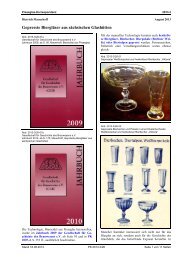
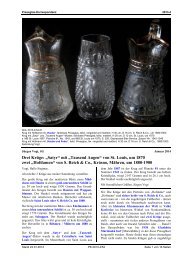
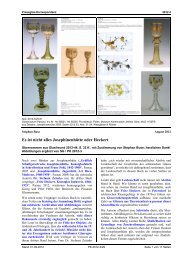
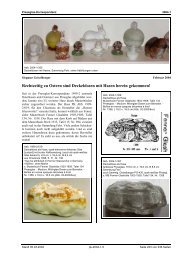
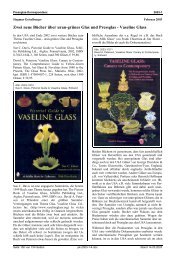
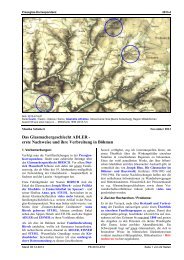

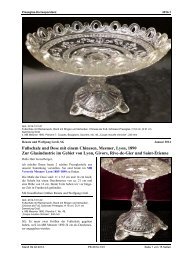
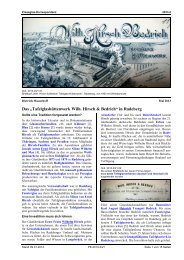
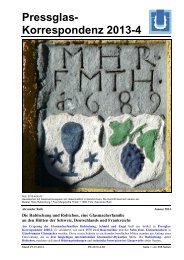
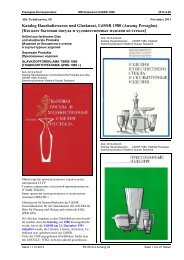
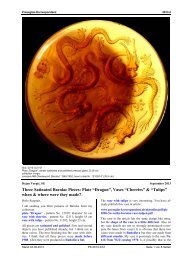
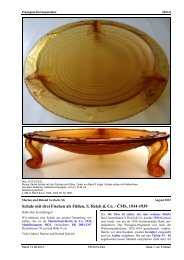

![Kapusta, Glasmachen im Bergland [Sklárstvà na horácku]](https://img.yumpu.com/25481954/1/184x260/kapusta-glasmachen-im-bergland-sklarstva-na-horacku.jpg?quality=85)